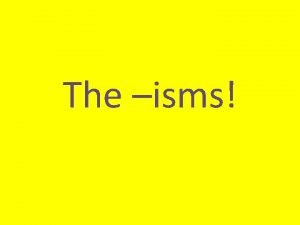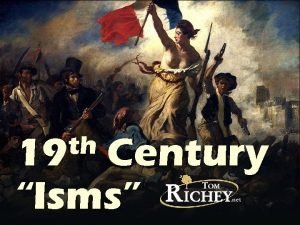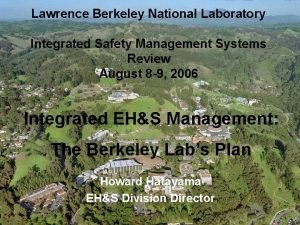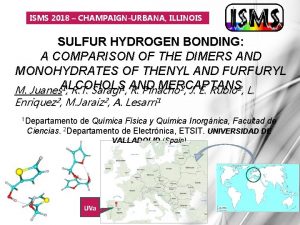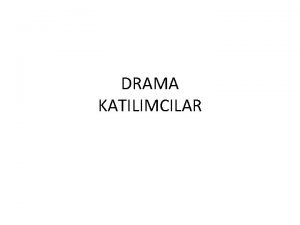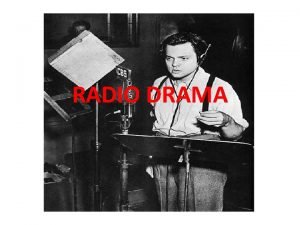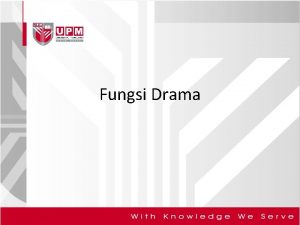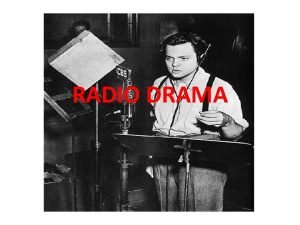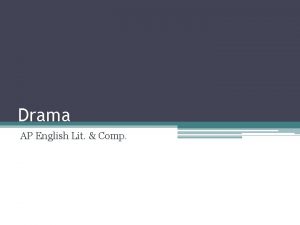The isms Drama 1 Europe in the 19
















- Slides: 16

The “isms” Drama 1

Europe in the 19 th Century n n From the Italian Renaissance on, pictoral illusion (“make it pretty”) dominated. Melodrama and Romanticism began to demand more realistic sets. Romanticism began in Germany and spread to all of the western world. It was a new view of human nature--a cross between church and humanity rather than a separation of the two.

Romanticism said that. . . n n n All that exists was created by an absolute being (God, Spirit, Idea, Ego) The less “spoiled” (altered) a thing is, the closer it is to embodying the fundamental truth--do not deviate from the natural, show things as they are. Dualities--humanity is longing for wholeness, but is held back by human limitations. Body/soul, physical/spiritual, good/evil, life/death, etc.

Romantic theory n n n Implies that complete happiness and truth are to be found only in the spiritual realm and cannot be attained fully during life. This, of course, is not at all what most people normally think of as “romantic. ” Romantic playwrights rejected the three unities and rejected the strict separation of comedy and tragedy--anti Neo-classic.

Realism said that n n Art (including theatre) must depict truthfully the real, physical world. Only the contemporary world can be viewed directly, so that is what should be depicted. Truth can be obtained most fully through impersonal, objective observation and representation of the contemporary world. What did she just say? : )

Breaking it down. . . n Truth can be obtained most fully through impersonal, objective observation and representation of the contemporary world.

More on Realism n n Realism was the belief that drama will move an audience profoundly only if it creates an illusion of reality. Old and new techniques were mixed together, so several types of productions were labeled “realism. ”

Fundamentals of Realism n n n Subject matter chosen from every day life. Settings duplicated real rooms Prose dialogue “Fourth wall” convention--no acknowledgement of the audience Boxed set--even added a ceiling. n n After 1850, used real furniture, prior had been painted cut outs. Authentic dress of the period of the play Gas and oil lights were now used. Props began to be functional (really knit, etc)

Symbolism n n n In 1885, Russians challenged the realistic look through symbolism. Subjectivity, spirituality, and mysterious internal and external forces were the sources of a truth more profound than that derived from the mere observation of outward appearance. Say what?

Breaking it down. . . n Subjectivity, spirituality, and mysterious internal and external forces were the sources of a truth more profound than that derived from the mere observation of outward appearance.

Symbolists’ Argument n Truth cannot be represented directly, but can only be evoked through symbols, legends, myths, and moods.

Symbolism Says. . . n n n Few properties Little furniture New lighting and use of gauze curtains Vague costumes Strongly stylized gestures

Absurdism n n n Came about in the 1950 s--the most recent of the isms. Concentrated on the irrationality of the human spirit without suggesting any path beyond. Plays are unified merely by a theme or mood instead of a cause-and-effect succession of events. Their structure paralleled chaos.

The Absurdist View n n Used incongruous events to produce seriocomic and ironic effects. Viewed language as a major rationalistic tool, so they frequently demonstrated its inadequacy.

Absurdity in Theatre n n Simplistic, representative sets Simplistic, representative props Simplistic, representative costumes Focus much more on language, gestures, and facial expressions

Absurdist Playwrights n Samuel Beckett – Waiting for Godot (1953) – Endgame (1957) n Edward Albee – “The Sandbox” (1959) n Eugene Ionesco – “The Bald Soprano” (1949) – “The Lesson” (1950) – “The Chairs” (1952)

